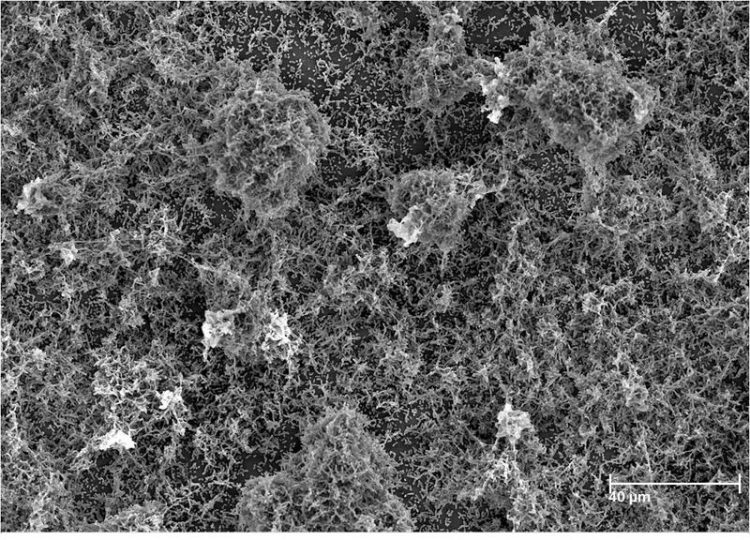Microorganisms Getting a Grip — Plasmids Control Marine Biofilm Formation

Phaeobacter inhibens DSM 17395 forming a biofilm Leibniz Institute DSMZ
Their diverse metabolic characteristics make bacteria of the Roseobacter group some of the most abundant microorganisms in nutrient-rich coastal waters. Roseobacters together with other bacteria form highly complex biofilms that have been dubbed “cities of microbes”.
However, they can also be found swimming freely in the oceans. Switching between mobile and sessile life styles is typical of many species of these marine bacteria. This flexibility is based on their ability to actively move with the help of flagella, while they are also capable of reversibly attaching to surfaces.
Jörn Petersen, a microbiologist at the Leibniz Institute DSMZ – German Collection of Microorganisms and Cell Cultures, in Braunschweig, Germany, and his colleagues have now demonstrated that the genes responsible for biofilm formation usually are located outside the bacterial chromosome on a single plasmid.
They reached this conclusion based on a physiological and genetic study of 33 Roseobacter strains. First, Petersen and colleagues showed that all bacteria that are efficient biofilm formers also are mobile. By removing the plasmids responsible for biofilm formation, they were able to demonstrate that the bacteria not only lost their ability of adhering to surfaces, but also their swimming capability.
“Thus, it is obvious that the responsible genes are located on these extrachromosomal elements,” said Petersen. Genes that are passed on via plasmids are able to cross the species boundary relatively easily. “Our studies show that even characteristics as complex as the ability of biofilm formation can be passed on via horizontal gene transfer,” said Petersen. Within the Roseobacter group, this type of horizontal gene transfer has actually happened multiple times, reflecting the great importance of plasmids for quick adaptation to new ecological niches.
The majority of the 33 Roseobacter strains studied were type strains, i.e., reference strains representative of the world’s bacterial diversity, which are archived in the DSMZ collection. Unlike previous studies, the DSMZ researchers genetically analyzed the group across its full evolutionary range. “Our present studies by far exceed anecdotal findings previously reported for individual model organisms. Moreover, they demonstrate the close link between basic research and collection activities here at DSMZ. As such, they also reflect DSMZ’s importance as one of the world’s leading resource centers for biological materials,” said Petersen.
The studies were supported by the Deutsche Forschungsgemeinschaft (DFG) and are part of the DFG Collaborative Research Center TRR51, “Roseobacter.” Results were recently published in Nature Publishing Group’s distinguished ISME Journal.
Further reading:
Original article:
Michael V, Frank O, Bartling P, Scheuner C, Göker M, Brinkmann H, Petersen J. (2016). Biofilm plasmids with a rhamnose operon are widely distributed determinants of the ʻswim-or-stickʼ lifestyle in roseobacers. ISME J [Epub ahead of print]. http://doi.org/10.1038/ismej.2016.30
Background:
Petersen J, Frank O, Göker M, Pradella S. (2013). Extrachromosomal, extraordinary and essential – the plasmids of the Roseobacter clade. Applied Microbiology and Biotechnology 97: 2805-2815.
Frank O, Michael V, Päuker O, Boedeker C, Jogler C, Rohde M, Petersen J. (2015). Plasmid curing and the loss of grip–the 65-kb replicon of Phaeobacter inhibens DSM 17395 is required for biofilm formation, motility and the colonization of marine algae. Systematic and Applied Microbiology 38:120-127.
Scientific contact:
PD Dr. Jörn Petersen
Department Protists and Cyanobacteria (PuC)
Head of Projekt A5 „Plasmide“ Transregio Sonderforschungsbreich (TRR51)
Phone.: 0531 2616-209
Email: joern.petersen@dsmz.de
About Leibniz Institute DSMZ
The Leibniz Institute DSMZ – German Collection of Microorganisms and Cell Cultures GmbH is a Leibniz Association institution. Offering comprehensive scientific services and a wide range of biological materials it has been a partner for research and industry organizations worldwide for decades. DSMZ is one of the largest biological resource centers of its kind to be compliant with the internationally recognized quality norm ISO 9001:2008. As a patent depository, DSMZ currently offers the only option in Germany of accepting biological materials according to the requirements of the Budapest Treaty. The second major function of DSMZ, in addition to its scientific services, is its collection-related research. The Brunswick (Braunschweig), Germany, based collection has existed for 42 years and holds more than 52,000 cultures and biomaterials. DSMZ is the most diverse collection worldwide: In addition to fungi, yeasts, bacteria, and archea, it is home to human and animal cell cultures, plant viruses, and plan cell cultures that are archived and studied there. http://www.dsmz.de
Media Contact
All latest news from the category: Life Sciences and Chemistry
Articles and reports from the Life Sciences and chemistry area deal with applied and basic research into modern biology, chemistry and human medicine.
Valuable information can be found on a range of life sciences fields including bacteriology, biochemistry, bionics, bioinformatics, biophysics, biotechnology, genetics, geobotany, human biology, marine biology, microbiology, molecular biology, cellular biology, zoology, bioinorganic chemistry, microchemistry and environmental chemistry.
Newest articles

A universal framework for spatial biology
SpatialData is a freely accessible tool to unify and integrate data from different omics technologies accounting for spatial information, which can provide holistic insights into health and disease. Biological processes…

How complex biological processes arise
A $20 million grant from the U.S. National Science Foundation (NSF) will support the establishment and operation of the National Synthesis Center for Emergence in the Molecular and Cellular Sciences (NCEMS) at…

Airborne single-photon lidar system achieves high-resolution 3D imaging
Compact, low-power system opens doors for photon-efficient drone and satellite-based environmental monitoring and mapping. Researchers have developed a compact and lightweight single-photon airborne lidar system that can acquire high-resolution 3D…





















